|
Q:
|
I'm a photo contributor but have lost my password, what should I do?
|
A:
|
You can retrieve your lost password quickly and easily by using the Photo Archive's
Lost Password Retrieval Feature. Just go to the
Lost Password page and enter the requested information to identify
yourself. Your login ID and password will then be e-mailed to you in only a few seconds.
If you can not do this for some reason, for instance if you have changed your e-mail address and forgotten your
password, you can contact me, the Photo Archive
curator, and I will manually look up your login information for you. Please use the automated form if at all possible
however, as I receive dozens of Photo Archive related e-mails every day, and it is very difficult to find time to reply to
them all. The automated form is also obviously much, much faster.
In any event, please do NOT ever create another contributor account for yourself. Duplicate contributor accounts create
a big problem for me, as I must routinely delete such accounts, consolidate their photos under one account, and contact the
contributor to explain what has happened. This is a very tedious, manual process, and take a tremendous amount of my time.
If I don't do so however, then things like the "Browse by Contributor", "View Contributor's Other Photos", and the Photo
Archive's award system will not work properly. So please, if you can't remember your login information and all else fails,
please contact me so I can try to help you out. Do not go ahead and create a second login ID for yourself.
|
|
Q:
|
Do you have a photo of [thus and such], perhaps that I can purchase?
|
A:
|
Unfortunately, no.
I do not sell photographs. The NERAIL Photo Archive is a completely free
web site that I run. It is available to anyone with Internet access at absolutely no charge,
and everyone has full access to every photograph in the site (there were
about 40,000 photographs available at the time this was written.) All that you need to do to
access the photos is to begin
browsing or searching the photos using the buttons on the left-hand side of this web page.
Please remember that all of the thousands of photographs on the site have been contributed by visitors to the
site such as yourself,
and every photo that has been contributed is available on the site (unless of course the original contributor has
chosen to remove it.) With such a large collection of photos, I obviously have no way of knowing each and every
photo that is available in the Photo Archive by heart, so I really can not answer questions about whether a
specific photograph is available or not. Your best bet to find a specific photo that you are looking for is to try
searching for it using the Photo Archive's search feature. I do not have any special access
to the site that allows me to search for photos any more efficiently than you can yourself, so unfortunately there
really is no way that I can offer more assistance than this.
I also do not have any additional photos in a personal collection that I do not
make accessible through the web site or anything like that, for sale or
otherwise, so if the photos that you are looking for are not already
available on the web site, I unfortunately will not be able to provide
them to you.
|
|
Q:
|
Can I post photos that someone else took?
|
A:
|
You can, but ONLY if you have their permission to do so, or if you are certain that you have the legal right to do so (for
example if the photos were taken by a deceased family member, your under-aged son or daughter, etc.) If you have photos that
you purchased at a railroad show or from someone else, even if they are original photos, that does not give you the legal
right to republish them. (Posting them to a web site is considered re-publishing.) You must contact the original
photographer or copyright holder and gain their permission to do so first.
|
|
Q:
|
Can I post scanned postcards?
|
A:
|
I am not an attorney or legal expert, and as such can not say for certain what the proper answer to this question is in
terms of copyright law. The general consensus though seems to be that historical/antique postcards that are no longer in print
are
considered within the public domain and can be republished by the person who owns the postcards. Therefore it should be safe
to post photos from old postcards, but please be aware that if someone does still hold a valid copyright on the photograph(s)
you may be putting yourself at risk by doing so. Please use your own common sense when deciding whether or not to post
such images.
|
|
Q:
|
Can I post photos that I found on another web site, on Usenet, or in a magazine or book?
|
A:
|
Absolutely not! Unless you have the photographer or copyright holder's written permission to do so.
This is a
very serious subject, and if you do this without obtaining such permission your posting access to the Photo Archive will
be permanently revoked! I hate to sound so unfriendly, but unfortunately many people seem to feel that anything they
find on the web they can use in whatever way they wish, including re-posting it or reusing it on other web sites. This is
absolutely not the case. Taking other people's photos (or other intellectual property) and reusing them without their
permission is illegal in the United States and most other countries. Doing so can get both you and I in to
serious trouble, and I will not allow such abuse of the Photo Archive to take place with my knowledge. Even if a photograph
does not have a copyright message printed on it, unless permission for it to be reused has been given by the copyright
holder, it is considered copyrighted, protected material under both US and international copyright law.
|
|
Q:
|
I have some photographs (or slides) that I would like to contribute to the Photo Archive, but I do not have the equipment to get
them in to my computer. Can you help?
|
A:
|
Yes. I have the equipment necessary to scan both photographs and slides, and am always happy to scan small numbers of photos
or slides and add them to the Photo Archive for people, at no cost, with the following limitations:
-
If you want me to return your photos or slides to you, you must include a self address, self stamped envelope/photo mailer
with enough postage to cover returning them to you.
- You must include a short and long description of each photo so I can add them to the Photo Archive. If you know the
date that the photo was taken, and the railroad it is from (if it isn't obvious from the photo) please include that as well.
If at all possible, please, please, please include the above information on a floppy disk, or in a separate e-mail to me,
rather than written or printed on a piece of paper. If written down or printed on a piece of paper, I will need to re-type
all of this information in to the Photo Archive system, which takes a considerable amount of time, especially given my typing
skills. :-) If you include it on disk or in e-mail, I can copy it in to the Photo Archive very easily, with very little
effort at all.
- Please do not send more than 15 photos at a time, unless you have contacted me ahead of time and I have said it is
alright to do so. Sometimes the time I have for doing this sort of thing is limited, and if you send a large batch of
photos unexpectedly, they may end up "on the back burner" for a long time while I try to find time for them. :-)
- Please understand that the Photo Archive is something that I do in my spare time, as a service to the railfan
community. I therefore can not always give a fast turnaround on scanning photos for people. Work,
life, family, and just about everything else sometimes gets in the way, and I can only scan photos when I have free
time available.
If you have a large number of photos or a collection you would like to contribute, please send me an
e-mail so we can discuss it, as I'm sure we will be able to work something out.
|
|
Q:
|
Why do you have a separate "New England" Railroad Photo Archive and "North American" Railroad Photo Archive? Why not
just have one? And why do the New England photos appear on both sites?
|
A:
|
This is a long answer, but this question gets asked of me quite a bit, so here goes. The reason for the odd splitting of the
sites in to New England and North American are based on the early history of the Photo Archive:
When I originally set up the Photo Archive way back in 1997 (yes, it has really been that long!) the intention was to create a simple web page to allow members of the NERAIL railfan discussion list to share photos with one another. The NERAIL discussion list was an Internet forum for New England railfans.
Since then, the Photo Archive has grown tremendously, and in some
ways has taken on a life of it's own, independent of the NERAIL discussion
list. These days most of the regular visitors and even contributors to
the Photo Archive are not even members of the NERAIL list. As this change happened, many of the people on the NERAIL mailing
list let me know that they felt offended by the many photos being posted form outside of New England.
I wanted to try to fix this problem while still trying to retain the original community spirit and
flavor of the Photo Archive. That is why I finally decided to split it in to two completely different web sites. The "North
American Photo Archive" is now the primary site. Photos from anywhere in North America (and occasional photos from other
locations) are now allowed in the North American Photo Archive. The other site, the NERAIL New England Photography
Archive is a subset of the full site. Basically, when you go to the New England version of the site, you'll see
only the New England photographs from the site.
With the above system, people now have a choice. They can view the full Photo Archive, or if they're only interested in
the original scope of the Photo Archive, they can view that version of the site, and see only the New England photos. There
is no need to view both sites however, since the New England photos appear on both. Just choose the one you like best and stick
with it. Also, please don't post the same photo to both sites, since as you can see from the above description, if you do so
your photo will appear twice in the New England version of the site. Just post your photo once, select "New England"
as the region, and it will appear on both sites automatically.
Note: for the geographically challenged among us, New England consists of
the following six states: Connecticut, Massachusetts, Maine, New
Hampshire, Rhode Island, and Vermont. (I sometimes get asked by people from far away if New
York or Pennsylvania are part of New England, they are not.)
Note that the Photo Archive family of web sites now also contains a Transit, Model Railroad, and Virtual Railroad (train simulator and artwork) web sites, which are completely separate from the New England/North American photo archives. Please be sure to visit all of them that interest you!
|
|
Q:
|
What is the largest size/resolution photo that can be posted?
|
A:
|
4920 x 3264 (16 megapixels)
For many years, the maximum size allowed was only 850 x 700. That was because when the Photo Archive was originally created, most people didn't have access to high resolution cameras, and website hosting space and bandwidth were both quite expensive. Because of the advances in technology that have taken place since then however, I was able to expand this in 2016 to 4920x3264 (16 megapixels). This is very close to the quality of scanned 35mm film (5380x3520).
When your photos are viewed on this site, they will still be displayed initially at the old resolution of 850x700, however if you click on the photo (or the "Full-Sized Image" link directly beneath it), you will see the full-sized image.
You may post photos of any size up to this maximum. I recommend using a resolution of 1600x1200 (2 megapixels) in most cases. This is the resolution of a standard 6"x4" photo print, and will display very nicely on most computers, tablets, and other devices even at full-screen. If you would like people to be able to print your photos feel free to use a higher resolution. 3264x2448 (8 megapixels) is suitable for printing at up to 11" x 8.5" for example, while 4920 x 3264 (16 megapixels) is suitable for up to 16" x 11" prints.
|
|
Q:
|
Are vintage photos allowed? The Photo Archive seems to only contain current, modern railroad photos.
|
A:
|
Yes, vintage photographs are allowed, and encouraged.
Many of the contributors to the Photo Archive are very active railfans
and photographers, and as a result have a steady source of modern era photographs to contribute. That's why there are so
many of them in the Photo Archive. Older photographs are always welcome however, so if you have them, please share them.
The only restriction on vintage photographs is that as with any photograph, you must either
be the photographer or have the legal right to republish the photograph before you can post it. Generally, this means that
old photographs that you have purchased, inherited, or taken yourself are ok to post, but photographs from old books
or magazines, or taken from other sites on the Internet are not.
There is some debate over whether old postcard photos can legally be republished. I have heard good arguments both for and
against. Some folks say that they are copyrighted, while others claim old postcards can be considered in the public domain.
Generally, photos from very old postcards (1800s or early 1900s) should be safe to post however.
|
|
Q:
|
I've taken a number of photos that I want to post. Do you have any tips on how to prepare them before I get started?
|
A:
|
Sure thing. There are several things that you can do to enhance the quality of your photos before uploading. Most of them
require photo editing software for your computer. I use Adobe Photoshop. This is a powerful (read "expensive") piece of
software however, which I also use for my business. For those on a budget, there are a number of other less expensive
software packages that can do all of the following as well. You may even have something that came with your computer,
scanner, or digital camera for free.
First and foremost, a good photograph starts with good photography. I am a web site developer, not a professional
photographer (in fact I'm not even much of an amateur photographer) ;-) so I can not provide too many tips in this area. In
general though, be sure that your subject is well lit from behind you if possible, in focus, and that there won't be a lot of
glare from reflective surfaces (don't take a photograph using the flash, pointed directly at a window for example.)
To steal a line from Hollywood, here are some examples of the good, the bad, and the ugly:
Once you have a good photo, there are a number of things you can do to enhance it. First, you should crop the photo
(remove some of it) so
that the eye is focused on the subject matter. This does not always mean cutting everything else out of the photo however.
Sometimes other objects can add interest or drama to a scene. You want to be sure that the photo isn't littered with
distracting items however, and that if you scanned the photo from a print or slide, that none of the border of the print or
slide is showing in your photo. Modern photo editing software makes cropping easy. Generally all that you need to do is
highlight the part of the photo you want to keep using your computer's mouse, and then select "crop" from the menu. Here are
a few examples:

Before
|

After
|
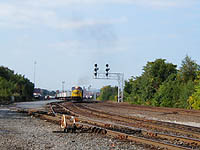
Before
|
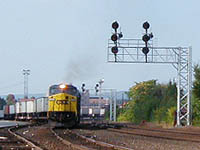
After
|
Next, resize your image. To get the best results, it's usually better to take photos with a digital camera set at a high
resolution, or scan a slide or print at a high resolution, then crop it, then resize it to the final resolution you want.
This gives you "more to work with", and will usually result in a sharper, more detailed photo than if you had started out at
the final resolution you wanted. The maximum width of photos contributed to the Photo Archive is 850 "pixels" (the dots that
make up the image on your computer screen), and the maximum height is 700 pixels. Be sure to resize your image to be within
these limits.
Next, be sure that your photo is properly exposed. Modern digital cameras often do a very good job of this automatically,
so you won't need to worry about it. If you are starting with a scanned print or slide however, you may find that it looks
"washed out", or just too dark or too light. The easiest way to fix this, if you have Adobe Photoshop, is to use the "auto
levels" feature. 95% of the time, one click on "auto levels" will almost magically fix all of your exposure problems for you.
It's not foolproof, but in many cases, it's more than good enough. If you do not have Photoshop, the photo editing software
you do have may have a similar feature, or failing that, you may be able to get acceptable results by manually fiddling with
it's "brightness" and "contrast" features (in your software, not on your monitor) ;-) until you're happy with the way the photo
looks. Here are a few more examples. Look at how bringing the levels up just a little bit brings out the details on that steam
engine!
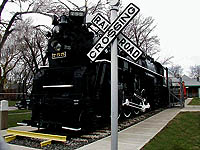
Before (underexposed)
|
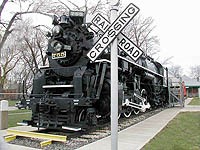
After
|
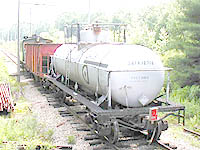
Before (overexposed)
|
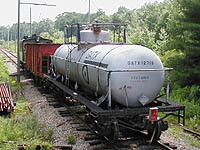
After
|
If you have started with a scanned print or slide, you will also want to "sharpen" it. Even the best consumer grade photo
scanners are still not able to produce the extremely sharp edges and details that a digital camera or studio quality scanner
can capture. Fortunately however, this sharpness and detail is easily brought out using photo editing software. In Adobe
Photoshop, this is done by selecting "sharpen" from the "filters" menu. You can do this more than once, and each time will
enhance the effect. Sometimes this can help to enhance even a poorly focused photo. It is easy to get carried away though,
especially when you first discover this feature. Over-sharpened photos look as bad as blurry ones, so generally only use one
pass unless you really need to use more. (If you constantly find yourself sharpening your photos 3 or 4 times, you're overdoing
it.) :-) An example, zoomed in a bit to show the sharpening effect clearly:
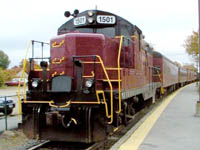
Before
|
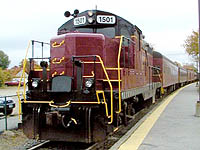
After
|
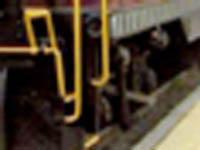
Before (close-up)
|
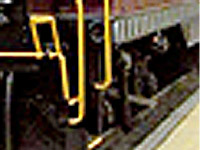
After (close-up)
|
That's about it! After cropping, resizing, adjusting levels, and sharpening, your photo should be ready to add to the Photo
Archive.
There are many more advanced things that can be done with photo editing software. It can even be used to restore color or
clarity to an old, faded photograph that you thought was a complete loss, or remove an object from a photograph completely
(like that telephone poll that got in front of your once in a lifetime shot of your favorite train.) Such things are beyond
the scope of these beginners tips, but I always encourage people to play with their photo editing software and have fun.
Once you've learned how to use some of the more advanced features, you'll be amazed at what you can do with it!
Here's a final example, showing all of the above techniques applied to a single photo. As you can see, just these few
basics steps can really make a big difference in the quality of your photos!
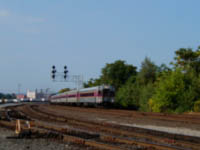
Before
|
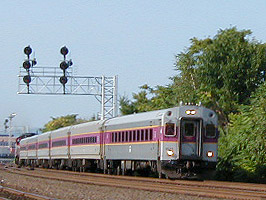
After
|
Yes, believe it or not, these images are both from the same scanned photo!
|